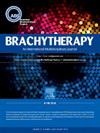High-Tailored Anal canal Radiotherapy (HIT-ART): Long term results of MR image-guided interventional radiotherapy (brachytherapy) boost
IF 1.7
4区 医学
Q4 ONCOLOGY
引用次数: 0
Abstract
PURPOSE
The aim of this study is to investigate the outcomes in terms of survival, treatment compliance and toxicity in a cohort of patients treated with personalized chemoradiation (RCT) followed by image guided Interventional Radiotherapy (IG-IRT), stratified by clinical baseline stage and treatment response.
METHODS AND MATERIALS
We analyzed patients with histologically proven squamous anal carcinoma treated using intensity modulated radiation therapy (IMRT) with curative intent, and IRT boost. External beam radiation was delivered using personalized IMRT technique with a simultaneous-integrated boost (SIB) to deliver 45 to 55 Gy in 25 fractions according to clinical stage. After the end of the RCT patients underwent clinical and imaging re-evaluation, and according to initial stage of disease and tumor response, a radiotherapy boost was administered through IG-IRT, performing MRI with IRT applicator on site (trans-anal position) and defining GTV on MRI imaging. All patients’ treatments and outcomes data were collected by an internal database. The endpoints were in terms of overall treatment time (OTT), toxicity, clinical complete response (cCR), locoregional failure (LRF), colostomy free survival, overall survival (OS) and disease-free survival (DFS). Univariate survival analysis with Kaplan- Meier curves was performed to allow between-group comparison.
RESULTS
73 patients treated between February 2012 and January 2023 were included in the analysis. 72.6 % were female, with a median age of 65.4 years (range 39.1–89). 62 were staged T2-T4 (T2 42.5.5%, T3 19.2%, T4 27.4%) and 50 (68.5%) had positive nodes. Combined RCT was administered mainly using mitomycin C and 5-fluorouracil. The mean dose received by patients was 50 Gy; after a median time of 43 days (range 9-128) a sequential boost dose was delivered in 1-2 fractions (median dose of 4 Gy). OTT median was 85 days (range 44–225). The median follow-up period was 50.6 months. LRF was 17.8%, and at 3 and 5 years LC was 80.1% and 77.2%, CFS was 80.5 and 77.8%, DFS was 79.3% and 75.9% and OS 95.1%, 84.3% and 61.4% at 10 years. Moreover, we verified that OS was higher in patients who had an OTT lower than 93 days. Toxicity was acceptable: 45.2% of patients experienced a G1-G2 abdominal discomfort (only 5.5% had G3).
CONCLUSIONS
Our experience confirms that MR Image Guided Interventional Radiotherapy boost is a feasible treatment option with a significant impact on outcomes.
高定制肛管放疗(HIT-ART):磁共振图像引导介入放疗(近距离治疗)的长期效果提升。
目的:本研究的目的是研究个体化放化疗(RCT)后图像引导介入放疗(IG-IRT)患者的生存率、治疗依从性和毒性,并根据临床基线分期和治疗反应进行分层。方法和材料:我们分析了组织学证实的使用强度调节放射治疗(IMRT)治疗的鳞状肛门癌患者,具有治愈目的,IRT增强。采用个性化IMRT技术,同时集成增强(SIB),根据临床分期分25次提供45至55 Gy的外部束辐射。RCT结束后,对患者进行临床和影像学重新评估,根据疾病的初始阶段和肿瘤反应,通过IG-IRT进行放疗强化,用IRT涂抹器在现场(经肛位)进行MRI,并在MRI成像上确定GTV。所有患者的治疗和结果数据均由内部数据库收集。终点包括总治疗时间(OTT)、毒性、临床完全缓解(cCR)、局部区域失败(LRF)、无结肠造口生存期(结肠造口生存期)、总生存期(OS)和无病生存期(DFS)。采用Kaplan- Meier曲线进行单因素生存分析,以便组间比较。结果:2012年2月至2023年1月期间接受治疗的73例患者纳入分析。72.6%为女性,中位年龄65.4岁(范围39.1-89)。T2-T4分期62例(T2 42.5.5%, T3 19.2%, T4 27.4%),阳性淋巴结50例(68.5%)。联合随机对照试验主要使用丝裂霉素C和5-氟尿嘧啶。患者接受的平均剂量为50 Gy;中位时间为43天(范围9-128天)后,分1-2次连续给予增强剂量(中位剂量为4 Gy)。OTT中位数为85天(范围44-225)。中位随访期为50.6个月。LRF为17.8%,3年和5年LC分别为80.1%和77.2%,CFS为80.5%和77.8%,DFS为79.3%和75.9%,10年OS为95.1%、84.3%和61.4%。此外,我们验证了OTT低于93天的患者的OS更高。毒性是可以接受的:45.2%的患者经历了G1-G2腹部不适(只有5.5%的患者经历了G3)。结论:我们的经验证实,磁共振图像引导介入放疗增强是一种可行的治疗选择,对预后有显著影响。
本文章由计算机程序翻译,如有差异,请以英文原文为准。
求助全文
约1分钟内获得全文
求助全文
来源期刊

Brachytherapy
医学-核医学
CiteScore
3.40
自引率
21.10%
发文量
119
审稿时长
9.1 weeks
期刊介绍:
Brachytherapy is an international and multidisciplinary journal that publishes original peer-reviewed articles and selected reviews on the techniques and clinical applications of interstitial and intracavitary radiation in the management of cancers. Laboratory and experimental research relevant to clinical practice is also included. Related disciplines include medical physics, medical oncology, and radiation oncology and radiology. Brachytherapy publishes technical advances, original articles, reviews, and point/counterpoint on controversial issues. Original articles that address any aspect of brachytherapy are invited. Letters to the Editor-in-Chief are encouraged.
 求助内容:
求助内容: 应助结果提醒方式:
应助结果提醒方式:


